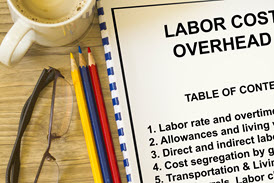Manufacturing Overhead Costs

To calculate Manufacturing Overhead by Job, be sure to include both manufacturing direct labor costs and manufacturing overhead labor costs.
How To Calculate Labor Cost
One key in calculating the labor cost portion of your manufacturing overhead is understanding the difference between manufacturing direct labor costs and manufacturing overhead labor.
Which of these should you include in your costing and pricing models?
Manufacturing Direct Labor Costs
Manufacturing direct labor costs include expenses associated with employees who are directly involved in the production of goods. These costs include wages, benefits, and any other compensation paid to workers who transform raw materials into finished products.
Manufacturing Overhead Labor Costs
Manufacturing overhead labor costs are for people who support manufacturing processes but don’t directly contribute to physically creating the product. This can include personnel like maintenance workers, quality control staff, or factory supervisors.
These roles are necessary for the smooth operation of the production process. However, they don’t directly participate in the actual transformation of raw materials into finished goods. Therefore, their wages and benefits are considered part of manufacturing overhead costs rather than direct labor costs.
Calculating Your Manufacturing Costs
Are you looking to put together an accurate manufacturing cost number? If so, you’ll want to include the cost of your direct labor plus the ‘burden’ accompanying that direct labor. And don’t forget to include related ‘manufacturing overhead’ labor costs.
Calculating Overhead Labor Costs by Employee
In addition to direct labor employees, there are normally 2 types of overhead employees in your labor force:
- People who may be strictly administrative. (Examples include marketing, bookkeeping, or accounting staff, company owners, administrative assistants, receptionists, janitorial staff, etc.). The relationship between the costs for these employees and finished products is typically very difficult to establish.
…  People who directly support the production process. For example:
People who directly support the production process. For example:
- Engineering or Design
- Supervisors and schedulers
- Purchasing
- Warehousing
- Quality Control
- Shipping
- Delivery
- Equipment repair and maintenance
- Others…
You should include the costs from Item 2 in your managerial and estimating calculations. They are an integral, supportive segment of the production process; think of them as indirect costs of production.
Labor-Burden Analysis
Using labor-burden analysis, you can determine exactly what each employee costs and then include both fully-burdened direct labor and fully-burdened indirect labor (‘production or manufacturing overhead’) costs into both your estimated and actual costs.
To Compute the Manufacturing Overhead Cost for Each Employee…
Owners need to consider:
- Whether the employee fits best into the direct labor, production support, or administrative category.
- The cost of regular and overtime payroll, payroll taxes, training, and benefits (a fairly extensive list!)
- Special equipment or vehicle requirements
- Facilities cost
- Costs flowing through from ‘manufacturing overhead’ types of workers
 For instance, a supervisor may ‘support’ a group of 5-10 other employees. If supervisors cannot assign their time to specific jobs, their fully burdened costs should flow through to the employees supervised.
For instance, a supervisor may ‘support’ a group of 5-10 other employees. If supervisors cannot assign their time to specific jobs, their fully burdened costs should flow through to the employees supervised.
In another example, a purchasing department may purchase the products needed by the production department, so those costs should either be assigned to specific jobs or flow through to the employees in the production department.
The idea is to ultimately assign or allocate all direct and indirect costs to the cost of the finished product so that you can get a realistic picture of estimated product costs.
When you also apply burden costs to job costing reports within your accounting system, you can compare estimated costs to the actual costs required to create your final product.
If you are creating inventory for sale at a later time, both direct costs and manufacturing overhead costs should be assigned to the inventory until it is sold. That way, you will be matching income from a sale to the applicable cost.
How Else Can You Use Direct Labor Costs and Manufacturing Overhead Labor Costs?
An informed and realistic view of your fully burdened labor costs will also help you determine whether you should:
- Authorize overtime and/or
- Hire and train new workers to take on excess workloads, tasks, and/or
- Outsource certain aspects of the manufacturing process – or bring various elements back in-house.
Without a detailed cost of labor analysis, you’ll be making these critical decisions based on gut instinct rather than on facts. And we all know that ‘guesstimates’ can be costly!
Where Does Manufacturing Overhead Fit Into Your Gross Profit Target?
The best way to proceed, of course, is to get a firm understanding of EVERY SINGLE element that rolls into your production cost – both direct and indirect production costs.
When you know what it really costs to create your product, you can price it to achieve your desired Gross Profit.
Of course, your target Gross Profit should be set high enough to cover both your true (non-production) company overhead costs as well as your desired bottom line profit.
Understanding Manufacturing Overhead
Don’t leave your employee’s per-production hour cost to industry averages, outdated analyses, or (what are often referred to as) ‘SWAGs’ (silly, wild-****’d guesses)!
When you know your total, fully-burdened labor rates (plus your other tangible production costs), you’ll be able to establish pricing based on reliable numbers and profitability targets.
That’s when you’ll be in a position to carefully and intelligently monitor and manage operations to achieve your bottom-line goals.
![]()
People Also Ask
FAQs (Frequently Asked Questions)
1. What is manufacturing overhead in accounting?
Manufacturing overhead includes all indirect costs incurred during the production process, such as indirect labor that supports the manufacturing process. It may also include rent, utilities, and equipment cost allocation.
2. Why is it important to calculate manufacturing overhead by job?
To understand the true, complete costs of jobs or products, you need to calculate and assign both direct and indirect costs to your products or projects. When you calculate and include manufacturing overhead, you have more accurate information at hand. When you have access to complete, accurate cost information, you’ll be able to analyze with insight, control costs, create accurate quotes and estimates, and make decisions that create greater profitability.
3. How do you calculate manufacturing overhead rate?
The manufacturing overhead rate is calculated by dividing total manufacturing overhead costs by an allocation “base” (or “driver”). For example, you could use direct labor hours, direct labor costs, machine hours, or any other measurable input directly related to production activity.
4. What are some examples of manufacturing overhead costs?
Examples include factory rent, utilities (electricity, water), property taxes, insurance, depreciation of factory equipment, cost of waste, recycling or disposal, and maintenance costs.
5. What is the formula for calculating total manufacturing overhead?
Total manufacturing overhead is the sum of all indirect costs incurred during production. It can be calculated as the sum of indirect materials, indirect labor, and other overhead costs.
6. How does QuickBooks help in calculating manufacturing overhead by job?
QuickBooks offers the ability to create a “special” Job (you may want to call it “Mfg O/H”) where you can assign manufacturing overhead costs. From there, you can decide how you want to allocate those overhead costs.
NOTE: If you want to customize QuickBooks Desktop to automatically allocate overhead costs to inventory, specific products, or projects based on direct labor compensation, you can use the eCPA (employee Cost & Pricing Analyzer) to discover your employees’ allocation percentages. Then, you can use the QuickBooks Payroll Module to auto-post your manufacturing overhead to Job costing and Inventory reports.
7. What are the benefits of using job costing in QuickBooks for manufacturing overhead?
Job costing in QuickBooks allows businesses to assign manufacturing overhead costs accurately to inventory, and to each job, which facilitates better cost management and decision-making.
8. What challenges do businesses face when calculating manufacturing overhead by job?
Challenges include accurately identifying and categorizing overhead costs, ensuring consistent allocation methods across jobs, and integrating overhead allocation with direct costs.
9. Can manufacturing overhead costs vary between different jobs?
Yes, manufacturing overhead costs can vary based on factors such as the complexity of the job, the duration of production, and the use of specialized equipment or resources.
10. Where can I find more resources and guides on calculating manufacturing overhead by job?
Additional resources and guides are available on the Build Your Numbers website.
![]()
“Fully-Burdened Labor Cost”
I.e., what it costs an employer for an employee to produce work for a specific period of time…
(…usually shown as a “per-hour” rate.)
Click the image above to learn more about our Excel-based tool that will help you learn everything you need to know about your employee costs and billing rates…
What our customers say about Diane Gilson and Info Plus Consulting:
⭐⭐⭐⭐⭐ From the Intuit FindAProAdvisor website:
“Diane is VERY knowledgeable, professional, and friendly. She was able to help in teaching me about Quickbooks. I would HIGHLY recommend.”
See More Customer and Client Comments
Bonus: Want to Increase your Gross Profit? Here’s a useful one-sheet Excel calculator…


